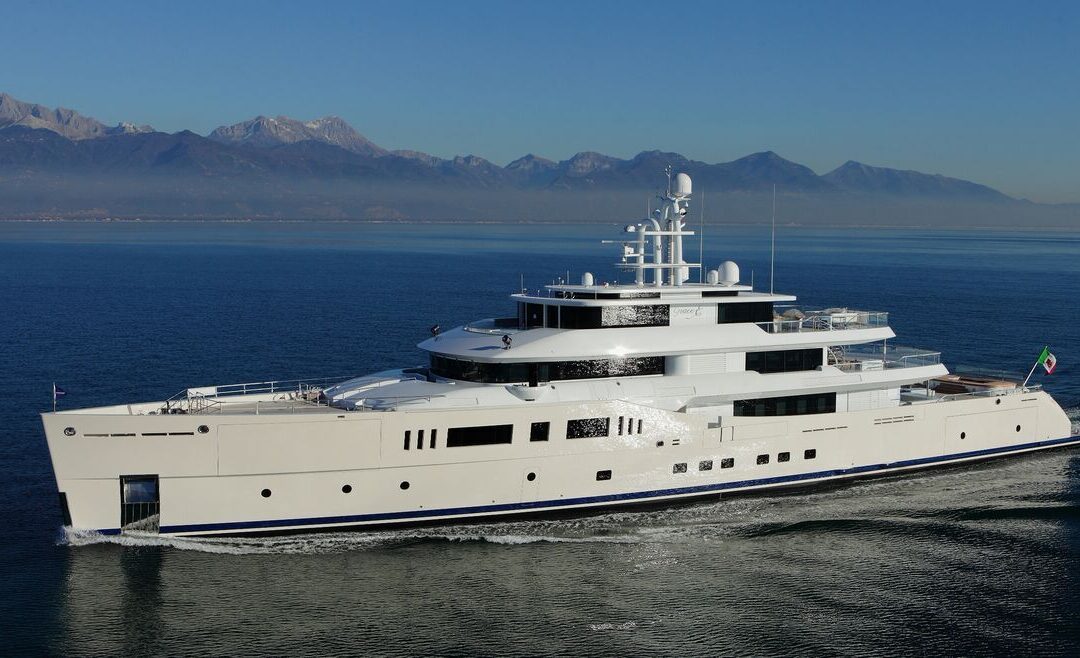Colette Flowerdew-Kincaid Investigates the Shipyard Eco-Uprising…
When Phillipe Briand designed the 73m Grace E, it is unlikely he predicted just how popular the vessel would be. The third motor-yacht built from his designs for Vitruvius Yachts, Grace E was delivered to her owners at the Picchiotti shipyard in La Spezia in 2014. She then went on to win countless awards the following year. For those who don’t know about her, her design includes a heavy focus on sustainability and efficiency. Fine water entry and a stretched hull guarantee low consumption, and this makes Grace E not only ideal for cruising and exploring the world, but also for preserving its natural wonders.
The combination of luxury, comfort and efficiency is said to be what defines the Vitruvius series. Grace E is a very well-balanced design; it is unlikely that energy-efficiency alone would have won all those awards. But it certainly helped. Efficiency was officially noted amongst the features that judges were impressed by, signposting that the superyacht industry has woken up to the need for boats with an environmental conscience. More and more yards are taking note of this.
Vitruvius is by no means the only shipyard to consider energy-efficiency in its builds, though many of these eco-builds have traditionally stayed under 50m. Italian builder ISA Yachts’ 43.6-metre Silver Wind is one good example, built with a hybrid propulsion system and powered by twin diesel engines driving Rolls-Royce Kamewa waterjets through reduction gearboxes. Her eco-friendly benefits include lower fuel consumption, gas emissions and noise levels. Another notable development has been the 47-metre Admiral Entourage from the Italian Sea Group, with a power package comprising twin C32 Acerts. And of course, who could forget Feadship’s 83.5m Savannah, the world’s first hybrid superyacht complete with a range of green technology running throughout vessel.

Ronno Schouten, head of design at Feadship, thinks that eco-innovation has already become a core part of the yacht building process. “Many innovations are based on increasing sustainability,” Schouten said. “Today it will actually be very hard to present a new innovation that does not take the environmental load into account.”
What will this mean for yachts? Some believe that in the future superyachts will be built to be more self-sufficient, with the means of producing certain foods onboard and integrated systems for reusing and recycling water and generating power. Progress towards this kind of vessel is already underway at German shipyard Nobiskrug Superyachts where a system allowing a yacht’s glasswork to produce power is currently in development. However, with yachts so personal to the owner’s individual tastes, it doesn’t seem likely that these kind of advancements will be included in all new builds. As with all other elements of the design, it will depend wholly on the mindset of the owner. But it is important that shipyards are prepared for when these requests come in.
To encourage this, we have seen a rise in award categories which specifically celebrate sustainable design. For example, Boat International’s Design & Innovation Awards now include a Best Ecological Design and Operation Innovation section. In order to win a superyacht must be seen to have made the most significant investment into design solutions, on board equipment and operational procedures that contribute to an improvement of its environmental performance beyond the minimum levels required by mandatory international regulations on environmental protection. Although the phrase ‘beyond the minimum levels required’ doesn’t inspire thoughts of incredible planet-saving technology, it’s definitely a good start.
Which takes us back to Grace E. The highly-celebrated vessel was awarded the Best Power Yacht in the 65m+ category at the International Superyacht Society Design Awards 2015, having won both the Best Motor Yacht Under 75m and Motor Yacht of the Year categories at the World Superyacht Awards earlier in the year, as well as three separate Showboats Design Awards for exterior design and styling, naval architecture and, you guessed it, environmental protection. So what was Briand’s thinking that led to such a clean-sweep?

“It’s all about society that we live in and just the right timing. Now the ‘green’ thinking became normal, people do care about environment and don’t want to pollute the Earth. For superyacht owners designing a boat, this aspect is not the priority but this is a very important criterion because it impacts the environment and the cost of maintenance as well. For some boats you need to pay 300 000 euros for fuel to just cross Atlantic. Not many owners are ready for costs like that nowadays,” he said.
Arguably, what makes the design special is the focus on the owner’s needs combined with an understanding that designing a more efficient boat is the way to meet those needs. Sustainability in this case also applies not just to the earth’s resources but also to the boat’s running costs and whether it would be possible for modern owners to sustain using it in the long run.
Briand may well be ahead of the curve when it comes to ‘green-thinking’. He has said in past interviews that he envisions the industry working towards an ultimate goal of yachts that produce no pollution of any kind, running completely quiet without any vibration. For now though, it is certainly reassuring to know that these issues are at the forefront of R&D in many shipyards around the world. And although there will always be the temptation to include products in the design which improve convenience but are no friend to the environment, maximising efficiency will always be a win-win for the owner and the earth. Sustainable superyachts? Bring it on.

